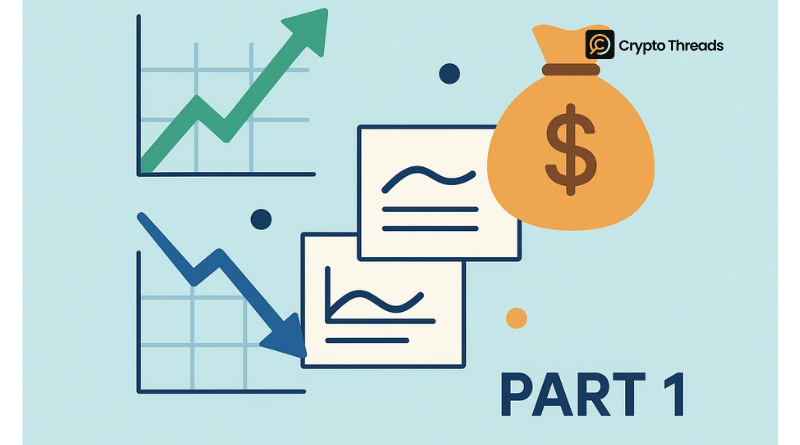Options 101: Advanced strategies with Options (part 1)
In the previous part, we have learnt about basic concepts and key terms in options trading, as well as some hedging strategies while holding long or short underlying positions. Let’s dive into options trading strategies in this part.
Option trading strategies and volatility
Typically, we can profit from options in two ways: by collecting premiums when selling options, or by exercising the right to buy low and sell high on the underlying security.
When selling options, sellers typically anticipate that the options will expire worthless, allowing them to retain the full premium without fulfilling the contract’s obligation. This implies that the underlying security will not move significantly in the direction of the option’s strike price.
On the other hand, buyers are betting that the price of the underlying asset will make a big move.
For example, if a trader believes that BTC’s price could reach $100k by the expiration date, they could buy a call option with a strike price of $95k. If the premium (cost) of the option is less than $5k, they stand to make a profit if the price goes up as expected. By contrast, if they expect the price to go down, they can buy put options with suitable strike price and premium. These are basic “long call” and “long put” strategies.
Hold on! So what’s the difference between options trading and other assets? Do you still have to predict the direction of the market? The answer is no. In option trading, you can buy or/and sell call and/or put options – at the same time and same amount, and still gain profit. What you need to predict is not the market direction, but the volatility (or how much the market moves in either direction).
When you bet on high volatility
If you bet on high volatility (but not in any specific direction), you can buy both call and put options, so you have the right to buy low and sell high on the expiration date. There are 2 common strategies based on this concept.
Long straddle: Buying both a call and put option with the same strike price and expiration.
Let’s take a look at an example
📌 Current Situation:
- Underlying Asset: Bitcoin (BTC)
- Current Price: $100,000
📌 Action: you bet on a large move of BTC next month, so you buy options
- Buy 1 Call Option with a strike price of $100,000 for $4,500 premium.
- Buy 1 Put Option with a strike price of $100,000 for $4,200 premium.
- Total cost to open the position: $4,500 (Call) + $4,200 (Put) = $8,700
📌 Outcomes in Different Scenarios:
🔼 Scenario 1: BTC Rises to $110,000 at Expiration
- Call Option: In-the-money by $10,000 ($110,000 – $100,000).
- Put Option: Out-of-the-money, expires worthless.
- Net Profit: $10,000 – $8,700 (initial cost) = $1,300 profit.
🔽 Scenario 2: BTC Falls to $90,000 at Expiration
- Put Option: In-the-money by $10,000 ($100,000 – $90,000).
- Call Option: Out-of-the-money, expires worthless.
- Net Profit: $10,000 – $8,700 (initial cost) = $1,300 profit.
➡️ Scenario 3: BTC Stays at $100,000 at Expiration
- Call Option: At-the-money, expires worthless.
- Put Option: At-the-money, expires worthless.
- Net Loss: Total premium paid: $8,700 (both options are worthless).
🔄 Breakeven Points:
- Upside Breakeven: $100,000 + $8,700 = $108,700
- Downside Breakeven: $100,000 – $8,700 = $91,300
As you can see, a long straddle gives you unlimited profit potential on the upside, and substantial profit on the downside. The maximum loss is the total premium.
Note that typically, ITM and ATM options cost more than OTM. Therefore we come up with the following strategy.
Long strangle: Buying an out-of-the-money call and put with different strike prices but same expiration.
📌 Current Situation:
- Underlying Asset: Bitcoin (BTC)
- Current Price: $100,000
📌 Action: You bet on a large move of BTC next month, but you are not sure in which direction. To lower the premium cost, you buy options with out-of-the-money (OTM) strike prices.
- Buy 1 Call Option with a strike price of $105,000 for $3,000 premium.
- Buy 1 Put Option with a strike price of $95,000 for $2,800 premium.
- Total cost to open the position: $3,000 (Call) + $2,800 (Put) = $5,800
📌 Outcomes in Different Scenarios:
🔼 Scenario 1: BTC Rises to $110,000 at Expiration
- Call Option: In-the-money by $5,000 ($110,000 – $105,000).
- Put Option: Out-of-the-money, expires worthless.
- Net Profit: $5,000 – $5,800 (initial cost) = $800 loss.
🔽 Scenario 2: BTC Falls to $90,000 at Expiration
- Put Option: In-the-money by $5,000 ($95,000 – $90,000).
- Call Option: Out-of-the-money, expires worthless.
- Net Profit: $5,000 – $5,800 (initial cost) = $800 loss.
➡️ Scenario 3: BTC Stays at $100,000 at Expiration
- Call Option: Out-of-the-money, expires worthless.
- Put Option: Out-of-the-money, expires worthless.
- Net Loss: Total premium paid: $5,800.
🔄 Breakeven Points:
- Upside Breakeven: $105,000 + $5,800 = $110,800
- Downside Breakeven: $95,000 – $5,800 = $89,200
The maximum loss is smaller than a long straddle, by contrast, it requires larger moves to be profitable.
When you bet on low volatility
If you anticipate low volatility, selling options allows you to collect premium income. However, if the market moves unexpectedly, you are obligated to fulfill the contract, which could result in unlimited losses.
Short straddle: Selling both a call and put with the same strike price and expiration.
📌 Current Situation:
- Underlying Asset: Bitcoin (BTC)
- Current Price: $100,000
📌 Action: You expect BTC to remain stable around $100,000 over the next month, so you sell options to collect premium.
- Sell 1 Call Option with a strike price of $100,000 for $4,500 premium.
- Sell 1 Put Option with a strike price of $100,000 for $4,200 premium.
- Total premium collected: $4,500 (Call) + $4,200 (Put) = $8,700
📌 Outcomes in Different Scenarios:
🔼 Scenario 1: BTC Rises to $110,000 at Expiration
- Call Option: In-the-money by $10,000 ($110,000 – $100,000).
- Put Option: Out-of-the-money, expires worthless.
- Net Loss: $10,000 (call payout) – $8,700 (premium collected) = $1,300 loss.
Note that the loss can be unlimited since the price has no maximum threshold.
🔽 Scenario 2: BTC Falls to $90,000 at Expiration
- Put Option: In-the-money by $10,000 ($100,000 – $90,000).
- Call Option: Out-of-the-money, expires worthless.
- Net Loss: $10,000 (put payout) – $8,700 (premium collected) = $1,300 loss.
Your homework: Let’s calculate the net loss in case BTC, somehow, disappears.
➡️ Scenario 3: BTC Stays at $100,000 at Expiration
- Call Option: At-the-money, expires worthless.
- Put Option: At-the-money, expires worthless.
- Net Profit: Total premium collected: $8,700.
As you can see, this strategy is high risk, especially when you don’t hold underlying assets. Therefore, traders come up with Iron condor to limit the risk
Iron condor: sell call and put options as straddle, but buy other call options at higher price than the call options you sell, and buy other put options at a lower price than the put options you sell
📌 Current Situation:
- Underlying Asset: Bitcoin (BTC)
- Current Price: $100,000
📌 Action: You expect BTC to remain within a certain range over the next month, so you construct an Iron Condor to collect premium while limiting risk.
- Sell 1 Call Option with a strike price of $105,000 for $2,500 premium.
- Buy 1 Call Option with a strike price of $110,000 for $1,200 premium.
- Sell 1 Put Option with a strike price of $95,000 for $2,300 premium.
- Buy 1 Put Option with a strike price of $90,000 for $1,100 premium.
Net Premium Collected:
- Sold Options: $2,500 (Call) + $2,300 (Put) = $4,800
- Bought Options: $1,200 (Call) + $1,100 (Put) = $2,300
- Total Premium Collected: $4,800 – $2,300 = $2,500
📌 Outcomes in Different Scenarios:
🔼 Scenario 1: BTC Rises to $108,000 at Expiration
- $105K Call Sold: In-the-money by $3,000.
- $110K Call Bought: In-the-money by $0.
- Net Loss on Call Spread: $3,000 – $1,200 (protection) = $1,800 loss.
- Puts: Both expire worthless.
- Net P&L: $2,500 (premium) – $1,800 (spread loss) = $700 profit.
🔽 Scenario 2: BTC Falls to $92,000 at Expiration
- $95K Put Sold: In-the-money by $3,000.
- $90K Put Bought: In-the-money by $0.
- Net Loss on Put Spread: $3,000 – $1,100 (protection) = $1,900 loss.
- Calls: Both expire worthless.
- Net P&L: $2,500 (premium) – $1,900 (spread loss) = $600 profit.
➡️ Scenario 3: BTC Stays Between $95,000 and $105,000 at Expiration
- All options expire worthless, and you keep the full premium.
- Net Profit: $2,500.
🔄 Breakeven Points:
- Upside Breakeven: $105,000 + $2,500 (premium) = $107,500
- Downside Breakeven: $95,000 – $2,500 (premium) = $92,500
As you can see, maximum profit is the total premium collected ($2,500) and maximum loss is the difference between the strikes ($5,000) minus the premium collected ($2,500), resulting in a $2,500 loss.
Conclusion
In conclusion, trading options is essentially a bet on market volatility, offering high reward potential but also significant risks, especially with strategies that carry unlimited loss. Premiums are a critical factor in determining profitability, influencing both risk and reward. Stay tuned for our next blog, where we’ll dive deeper into option pricing models to help you navigate this complex landscape more effectively.



